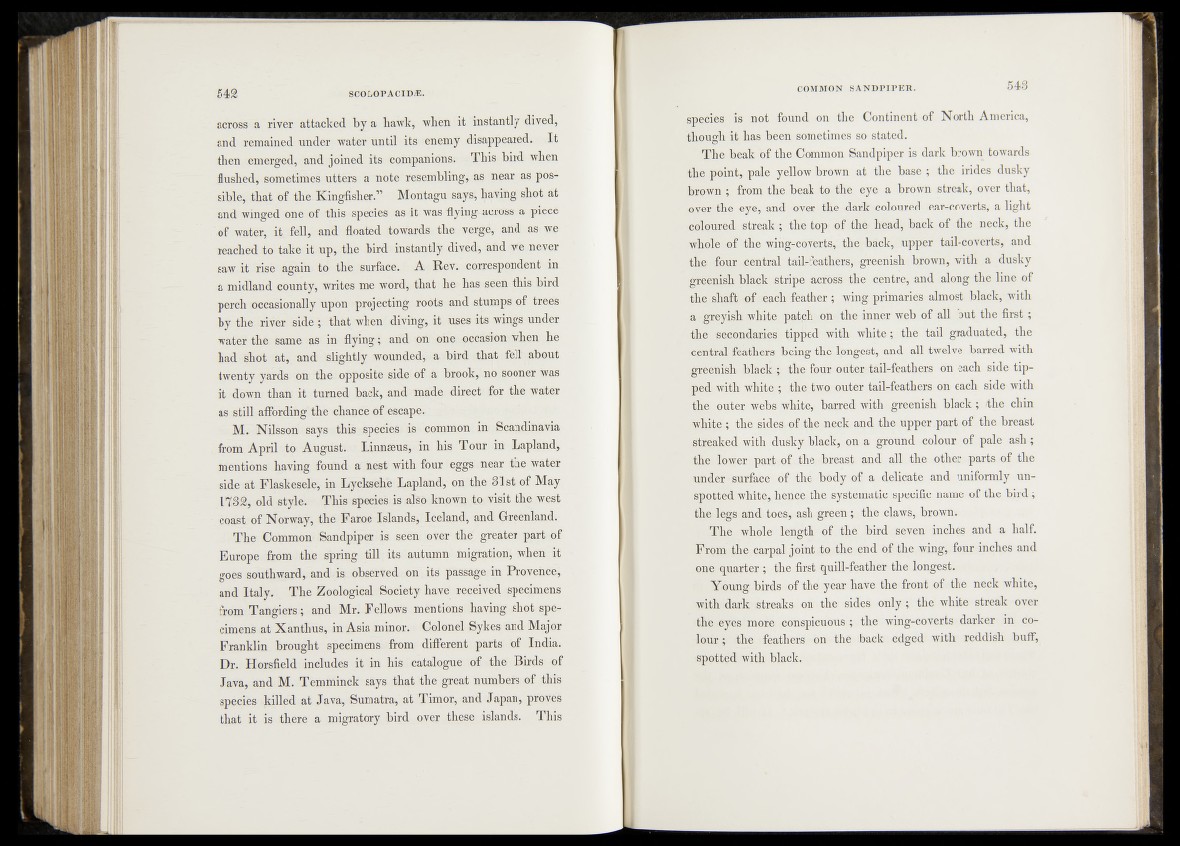
542 sco lo pac id j :.
across a river attacked by a hawk, 'when it instantly .dived»
and remained under water until its enemy disappeared. I t
then emerged, and joined its companions;- j|This bird when
flushed, sometimes miters a note' resembling, as near as possible,
that csfethsi, Kingfisher^ Montagu: says, having, shot at
and winged one of this species as-it was flying~across a piece
.of .water, if fell, and floated towards- the verge, and as we
reached to taknit up,.the -bird instantly dived, and we never
saw it rrise again to the surface. A Rev. correspondent in
a midland county, writes me w.drd^that he has seen this bird
perch 'occasionally upon projecting roots and stumps-^of trees
by the river side.;- that when diving, it uses -its wings under
water the same as in flying; and on ,one, occasion^when he
had shot at, and Slightly wounded»'ra bird that fell about
twenty yards on~the^ opposite side of-a brook, no.sooner was
It down than it turned- back, and made direct for the water
as still affording the chance of escape. .
M. Nilsson says this species is common in Scandinavia
from April to August. Linnaeus, in his Totir in Lapland,
mentions having found a' nest with four eggs near the water
side at Flaskesele, in Lycksehb Lapland,' on the 31st of May
old style. This species is nfeo know5 ^.Qf;Visit the^wtesj
coast .of Norway, the Faroe Islands,^Iceland,l'§nd Greenland.'
| The Common* Sandpiper is, seen' over the greater part of
Europe from the spring ;till;its^autumn migration,' 'when it
goes southward, and usjL.observed on its passage in Provence»
and Italy. The Zoological Society- hay# received specimens
from Tangiers; and Mr. Fellows mentions having shot-specimens
at Xanthus, in Asia minor, j Colonel Sykes and Major
Franklin brought specimens from different parts of India.
Dr. Horsfield includes it in his catalogue of the Birds of
Java, and M. Temminck says that the great numbers of this
species -killed at Java, Sumatra, at Timor, and Japan, proves
that it is there a migratory bird over these islands. This
species^ is not found on the Continent of North America,
though h has been sometimes so stated.
The beak of the Common Sandpiper is dark brown towards
the point, pale yellow brown at the base ; the irides dusky
,%r©yra ; from the beak to the eye a brown streak, over that,
;$>$er,theL$y#,i:and .over the dark coloured ear-coverts, alight
^ j ^ r e d . streak,; the top of the héad, back of the neck, the
whole .of the wing-coVerts,. the back, upper tail-coverts, and
the fouM^entral tail-feathers,, -greenish brown, with a dusky
greenish black stripe across the-»centre, and along the line of
the .shaft of Jeach feather ; wing primaries almost black, with
, a f greyish white,: patch on the inner web of all but the first;
!,t^p /-secondaries tipped with white; the tail graduated, the
-central fèathers being the longest, and all twelve barred with
greenish black ;g|he four o$fer-f ail-feathers on each side tipped
with whiter; the two outer tail-feathers on each side with
the outer webs white, barred with greenish black; <the chin
white;- the sides^eff.themeek and the upper part of the breast
„stak ed with dusky black, on a ground colour of pale ash;
the lower part of the breast and all the other parts of the
under - surface of thé body of a delicate and uniformly unspotted
white, hence the systematic specific name of the bird;
the legs and toes, .ash green; thé claws, brown.
The whole length of the bird seven inches and a half.
From the carpal joint „to the end of the wing, four inches and
. .eijéy quarter ; the first quill-feather the longest.
Young birds of the year have the front of the neck white,
with dark streaks on the sides only; the white streak over
the ..eyes more conspicuous; the wing-coverts darker in colour
; the feathers on the back edged with reddish buff,
spotted with black.